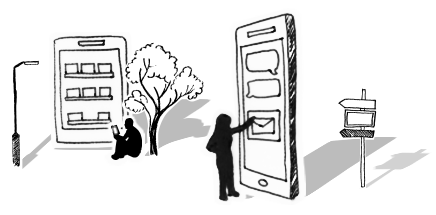




The Importance of Values: Put the Client First
Putting the client first. As with many core values, it sounds like the right thing to say, but it’s one of those phrases where the more you think about it, the more there is to it. So, what does putting the client first actually mean for an organisation that wants to live and breathe this value?
Initially, the phrase “putting the client first” may conjure up images of pulling all-nighters to meet a deadline, missing the kids’ school disco and answering your phone in the middle of Sunday dinner in order to cater to the every whim of a client.
But this isn’t what putting the client first means, or at least it’s definitely not what it should mean. Putting the client first doesn’t mean that the client is always right. And it doesn’t mean that anything the client says, goes.
Putting the client first is realising and embracing that clients are the backbone of any organisation, and that when clients succeed, the organisation succeeds.
Two ears, one mouth
Putting the client first is about putting yourself in their shoes. It’s about listening to them, hearing them, recognising their point of view and incorporating this into the way forward.
Why? Because even though you’re the expert in the product or service you provide, the client is the expert in their organisation. Although they are trusting you to deliver for them, professing to know more about their own organisation than they do is a recipe for friction, cookie-cutter solutions and, ultimately, poor results.
For example, at Afiniti, we deliver change management consulting for global organisations with thousands of employees. All of the work we do is bespoke for each engagement, because no two change programmes are identical. If we delivered generic templates without input from the client, because “we know what’s best”, the result would be a bland, uninspiring campaign that was relevant for few and engaged even less.
By listening to the client and taking time to get to know them to build bespoke solutions, you’re not only delivering something that has a higher likelihood of success, you’re demonstrating that you’re putting them first by considering their specific requirements.
“If you focus on easing their burden and making them shine, you’re on the right track to being that valued partner.”
Become a partner
In order for a client to feel truly valued, they need to believe that you’re as invested in their success as they are. Listening to their needs and getting to know them, as outlined above, certainly helps with this. But by making their success a part of your success – rather than concentrating on just closing the deal or finishing the work – you become more than a provider or a supplier; you become a trusted partner.
This can take many forms. During transformation engagements, Afiniti are sure to promote the fantastic work the client change sponsors are doing across their organisations, for example by entering them into industry awards. Not only does this strengthen their internal relationships and reputation, it gets them more invested in the change, enhances adoption and affirms the belief that we really do care about our clients throughout the entire engagement cycle.
Becoming more than a supplier for your clients will be unique for you, but if you focus on easing their burden and making them shine, you’re on the right track to being that valued partner.
Responsive and reliable
I’ve already stated that putting the client first isn’t about overworking yourself to meet their every need. And, if you’ve taken the time to listen to their requirements and understand or set expectations, this shouldn’t be necessary.
That said, you should still aim to over-deliver where possible. Maybe that does mean working late sometimes to meet a last-minute deadline. It might mean providing additional information than is necessary to add further value and show your support.
Whatever over-delivering looks like for your organisation, you should aim to be responsive to your clients’ needs; even if you need to tell them something they might not want to hear, doing so quickly and clearly will make for a far better experience than delaying the difficult conversation.
By being quick to respond and keen to over-deliver, you create trust in your relationship that proves you’re putting the client first. And, after all, any good relationship comes down to trust.
The opportunity of openness
Speaking of trust, transparency is also key to putting the client first. Regular and open communication with clients breeds trust, removing uncertainties along their journey that can cause fear or apprehension.
And transparency is a two-way street; by inviting clients to feed back on your service, you can establish the trust you place in them by welcoming their input as well as demonstrate commitment to improving your services for them.
If things do go wrong, then the old adage rings true: honesty is the best policy. Open and frank conversations when mistakes are made can ensure they are resolved effectively. That honesty also shows your respect for the client, and can you ever really put the client first if you don’t truly respect them?
Putting the client first in practice
While the principle may make sense, actually committing to and delivering on this client-first mindset is easier said than done. Driving such a culture change, particularly in large organisations, could require major transformation.
Of course, while Afiniti can help with that, for the purposes of this article I wanted to leave you with some immediate actions you can take to begin your journey of putting the client first:
- Listen first, speak second – when speaking with a client, prospective or existing, make sure you’re taking the time to ask and record what their specific needs are, for example by making this a primary section in your CRM or scoping document. If your doctor prescribed you pills before you’d told him your symptoms, would you take them?
- What will good look like? – once you know what your client needs, don’t just offer the bare minimum to achieve this. Take some time to consider, based on your experience and their expectations, what a satisfactory outcome will look like for them. Then, decide how you might be able to over-deliver on this (in a way that makes commercial or logistical sense). If you can go above and beyond, then why wouldn’t you?
- Communication is key – ensure you are regularly checking in with or updating the client so they are constantly assured of your progress and competence. The frequency required will vary depending on your offering, but whatever you decide is right, set yourself calendar reminders, schedule emails or even use post-it notes to remind yourself not to leave any client in the dark.
- The end is just the beginning – once you’ve (over)delivered for your client, ask them for feedback, either informally in a closing conversation or through recognised platforms like Google Reviews or Trustpilot. Not only is the feedback useful for brand and service enhancement, you will show the client their opinions are valued and that they are just as much a part of your organisation as you’ve been for theirs.
Putting clients first is one of our core values at Afiniti because we know from over two decades’ experience in change management that it is essential to successful transformation.
If you need support driving your own culture change, get in touch and we’ll be happy to demonstrate how we put clients like yourself first.
The next Insight in our ‘Core Values Series’ will look at how “Acting with Integrity” helps deliver effective, sustainable change for our clients.
To get the latest change tips, advice and guidance directly to your inbox, sign up to our monthly Business Change Digest.

